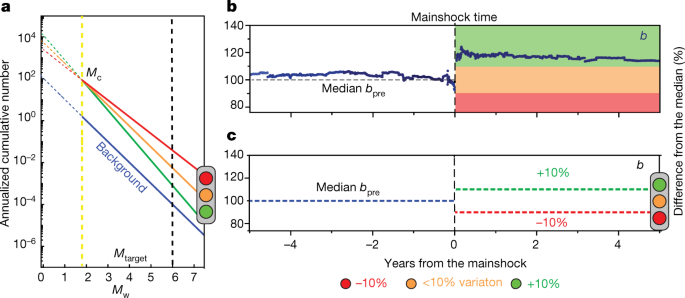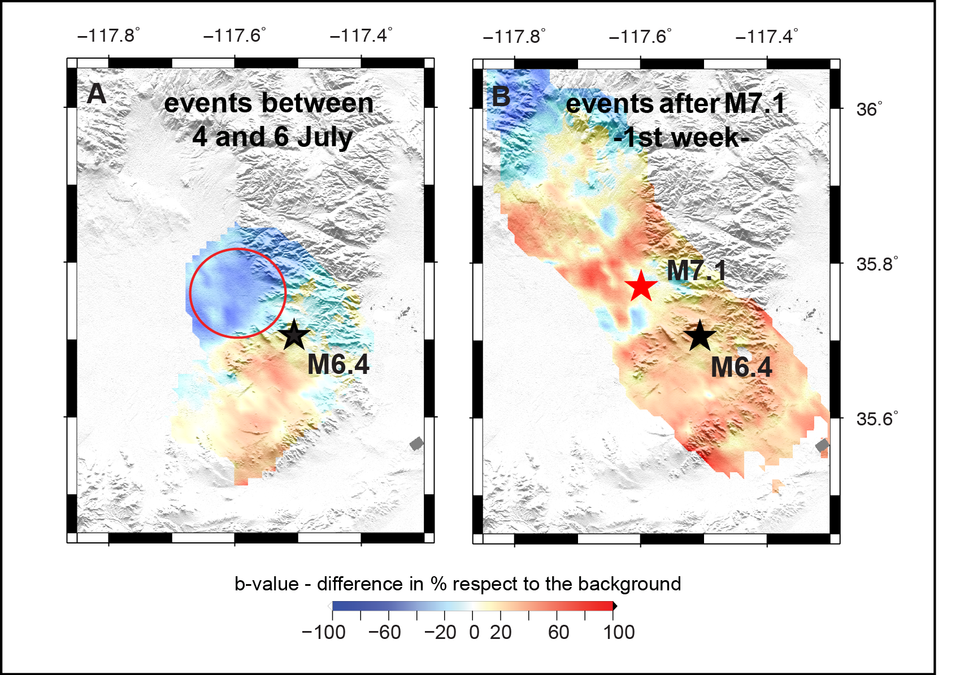Figure 1. The foreshock traffic light system. Schematic representation of FTLS in the frequency–magnitude distribution view (a) and the b-value time-series view (c). Green denotes an aftershock sequence with a b-value increase of about 20%, where no mainshock is expected; yellow indicates that the b- value remains unchanged in the aftershock sequence or is difficult to determine; red means that the b-value decreases considerably and mitigation actions must be considered since a new energetic quake can occur. b) b-value stacking of 31 sequences, showing the percent difference with respect to the reference value, bpre (that is, the black horizontal dashed line which represents the median of the background b-values). The black vertical dashed line represents the time of the mainshock, shifted to zero [image from 1].
What is the idea behind?
In seismic regions, the b-value is commonly close to 1 and, for long, most of the scientists considered it stable in time and space. However, in the last decades, different studies and laboratory measurements showed that the b-value space-time variability is inversely correlated to the state of stress in the Earth’s crust [3, 4]. From the analysis of 58 well-monitored seismic sequences from California, Japan, Italy and Alaska, we demonstrated in 2018 [5] that the b-value changes systematically during an earthquakes’ sequence and that it increases by about 20% after the biggest event of the sequence (in other words the mainshock).
Based on this observation, the FTLS indicates whether or not an even more powerful earthquake would follow in the ongoing seismic sequence. It turns to green if, after an event with magnitude (M) greater or equal than 6, the b-value increases by at least 10% and indicates that no other mainshock is expected. It turns red if the b-value drops 10% or more indicating that another energetic shock may occur and mitigations plans should be considered. Finally, it turns orange when the b-value rises or falls by less than 10%, which means that the scenario is still unclear (Fig. 1).
We reversed the usual point of view: instead of focusing on what happens before an earthquake, we analysed what happens after
When did you start studying the b-value?
It was 2004 when I first read the papers by Max Wyss, Stefan Wiemer and Danijel Schorlemmer about the b-value and its inverse correlation to the state of stress in the Earth crust [6, among others]. Soon I found the topic extremely interesting and it seemed so clear to me that the b-value was a key-parameter in seismology. A couple of years later, I spent one month at ETH in Zurich for my PhD and that has been the first step in the path that led to the intuition at the basis of the FTLS…
…what was this intuition?
The search for common patterns preceding an earthquake, the so-called precursors, is what scientists did so far. Well, we reversed the usual point of view: instead of focusing on what happens before an earthquake, we analysed what happens after… And this was the intuition! More simply, in the aftermath of an M>=6, we monitor the b-value: is it increasing, as we would expect after a mainshock? If not, that event was not the mainshock and a bigger event has yet to come; if yes, that event was the actual mainshock. I like to define it as prediction with hindsight!
How do you calculate a “reference b-value” for the background and why is this so important?
The reference b-value is a critically important value since the FTLS decisions are based on the difference in the percentage of the sequence-specific b-values in comparison with a reference value. To establish this value, we first build the fault plane of the event with M>=6; we then select all the earthquakes within 3km distance in the years preceding the M>=6 event. In a moving window approach, we calculated the b-value for the first 250 events and move event by event. The mean of all these single estimations is our reference b-value. A dense seismic network as well as several years of past data are essential for a successful implementation of the model.
Have you ever tested the Foreshock Traffic Light System in real-time during a seismic sequence?
The model has been submitted in February 2019 to Nature and, since that moment, never modified. During the revision process, in July 2019, an M6.4 hit Ridgecrest, California. We were all wondering: “was it the mainshock?”. We then tested our model pseudo-prospectively and the results were very promising: after the M6.4 event, the FTLS turned to red, indicating that a stronger earthquake was still probable to hit Ridgecrest and, just after a couple of days, an M7.1 hit a few km from the M6.4 epicentre! After this second event, the FTLS gave green light and, until today (15 months after) there has not been any bigger event. Further, by mapping the b-value variation, we could also locate where the M7.1, the actual mainshock, was expected to nucleate [7] (Fig. 2).


